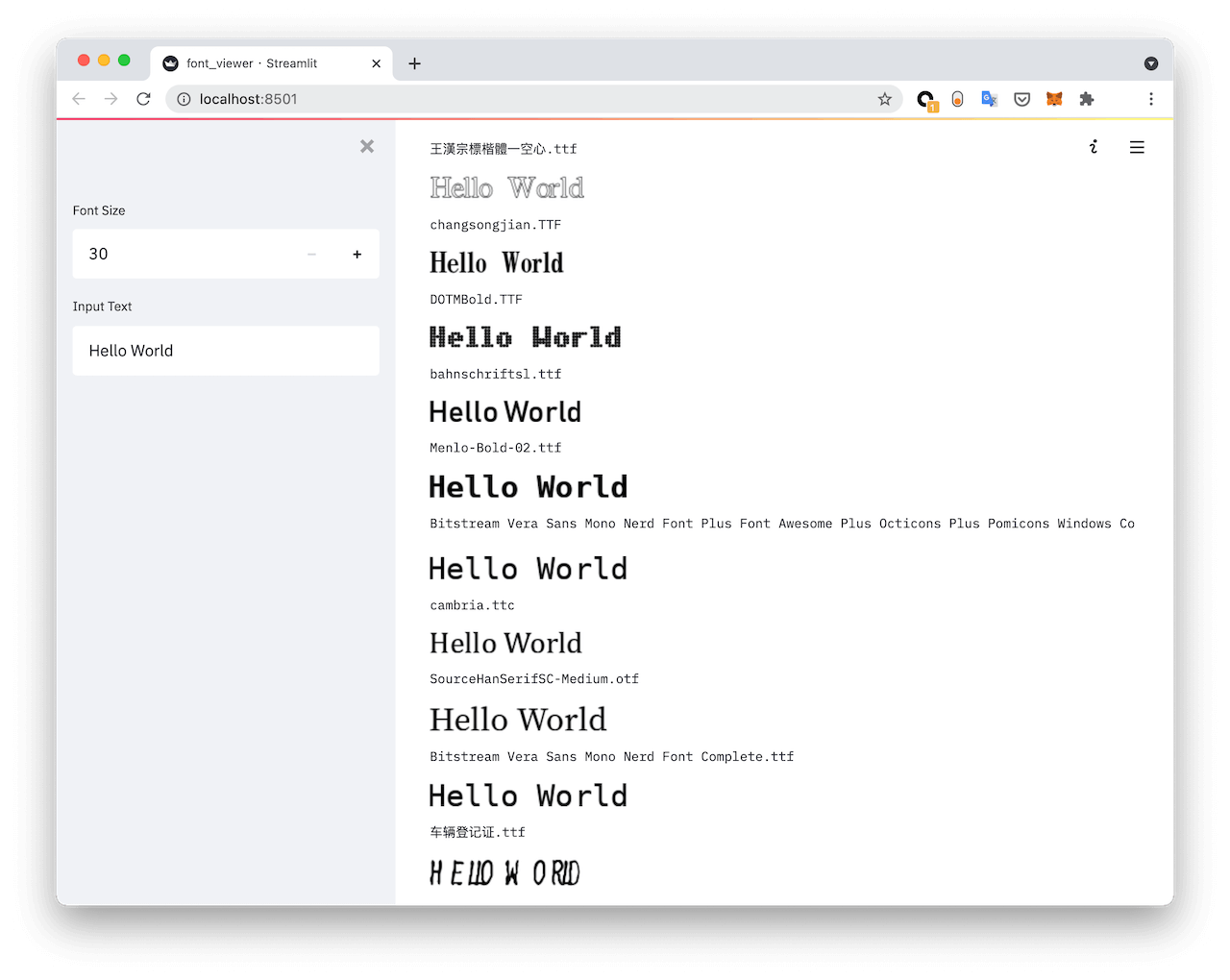Generate text line images for training deep learning OCR model (e.g. CRNN). 
- Modular design. You can easily add different components: Corpus, Effect, Layout.
- Integrate with imgaug, see imgaug_example for usage.
- Support render multi corpus on image with different effects. Layout is responsible for the layout between multiple corpora
- Support apply effects on different stages of rendering process corpus_effects, layout_effects, render_effects.
- Generate vertical text.
- Support generate
lmdbdataset which compatible with PaddleOCR, see Dataset - A web font viewer.
- Corpus sampler: helpful to perform character balance
Run following command to generate images using example data:
git clone https://github.com/oh-my-ocr/text_renderer
cd text_renderer
python3 setup.py develop
pip3 install -r docker/requirements.txt
python3 main.py \
--config example_data/example.py \
--dataset img \
--num_processes 2 \
--log_period 10The data is generated in the example_data/output directory. A labels.json file contains all annotations in follow format:
{
"labels": {
"000000000": "test",
"000000001": "text2"
},
"sizes": {
"000000000": [
120,
32
],
"000000001": [
128,
32
]
},
"num-samples": 2
}You can also use --dataset lmdb to store image in lmdb file, lmdb file contains follow keys:
- num-samples
- image-000000000
- label-000000000
- size-000000000
You can check config file example_data/example.py to learn how to use text_renderer, or follow the Quick Start to learn how to setup configuration
- Font files:
.ttf、.otf、.ttc - Background images of any size, either from your business scenario or from publicly available datasets (COCO, VOC)
- Corpus: text_renderer offers a wide variety of text sampling methods, to use these methods, you need to consider the preparation of the corpus from two perspectives:
- The corpus must be in the target language for which you want to perform OCR recognition
- The corpus should meets your actual business needs, such as education field, medical field, etc.
- Charset file [Optional but recommend]: OCR models in real-world scenarios (e.g. CRNN) usually support only a limited character set, so it's better to filter out characters outside the character set during data generation. You can do this by setting the chars_file parameter
You can download pre-prepared file resources for this Quick Start from here:
Save these resource files in the same directory:
workspace
├── bg
│ └── background.png
├── corpus
│ └── eng_text.txt
└── font
└── simsun.ttf
Create a config.py file in workspace directory. One configuration file must have a configs variable, it's
a list of GeneratorCfg.
The complete configuration file is as follows:
import os
from pathlib import Path
from text_renderer.effect import *
from text_renderer.corpus import *
from text_renderer.config import (
RenderCfg,
NormPerspectiveTransformCfg,
GeneratorCfg,
SimpleTextColorCfg,
)
CURRENT_DIR = Path(os.path.abspath(os.path.dirname(__file__)))
def story_data():
return GeneratorCfg(
num_image=10,
save_dir=CURRENT_DIR / "output",
render_cfg=RenderCfg(
bg_dir=CURRENT_DIR / "bg",
height=32,
perspective_transform=NormPerspectiveTransformCfg(20, 20, 1.5),
corpus=WordCorpus(
WordCorpusCfg(
text_paths=[CURRENT_DIR / "corpus" / "eng_text.txt"],
font_dir=CURRENT_DIR / "font",
font_size=(20, 30),
num_word=(2, 3),
),
),
corpus_effects=Effects(Line(0.9, thickness=(2, 5))),
gray=False,
text_color_cfg=SimpleTextColorCfg(),
),
)
configs = [story_data()]In the above configuration we have done the following things:
- Specify the location of the resource file
- Specified text sampling method: 2 or 3 words are randomly selected from the corpus
- Configured some effects for generation
- Perspective transformation NormPerspectiveTransformCfg
- Random Line Effect
- Fix output image height to 32
- Generate color image.
gray=False,SimpleTextColorCfg()
- Specifies font-related parameters:
font_size,font_dir
Run main.py, it only has 4 arguments:
- config:Python config file path
- dataset: Dataset format
imgorlmdb - num_processes: Number of processes used
- log_period: Period of log printing. (0, 100)
Find all effect/layout config example at link
bg_and_text_mask: Three images of the same width are merged together horizontally, it can be used to train GAN model like EraseNet
Setup Commitizen for commit message
- Corpus: Feel free to contribute more corpus generators to the project, It does not necessarily need to be a generic corpus generator, but can also be a business-specific generator, such as generating ID numbers
Build image
docker build -f docker/Dockerfile -t text_renderer .Config file is provided by CONFIG environment.
In example.py file, data is generated in example_data/output directory,
so we map this directory to the host.
docker run --rm \
-v `pwd`/example_data/docker_output/:/app/example_data/output \
--env CONFIG=/app/example_data/example.py \
--env DATASET=img \
--env NUM_PROCESSES=2 \
--env LOG_PERIOD=10 \
text_rendererStart font viewer
streamlit run tools/font_viewer.py -- web /path/to/fonts_dircd docs
make html
open _build/html/index.htmlIf you use text_renderer in your research, please consider use the following BibTeX entry.
@misc{text_renderer,
author = {oh-my-ocr},
title = {text_renderer},
howpublished = {\url{https://github.com/oh-my-ocr/text_renderer}},
year = {2021}
}























